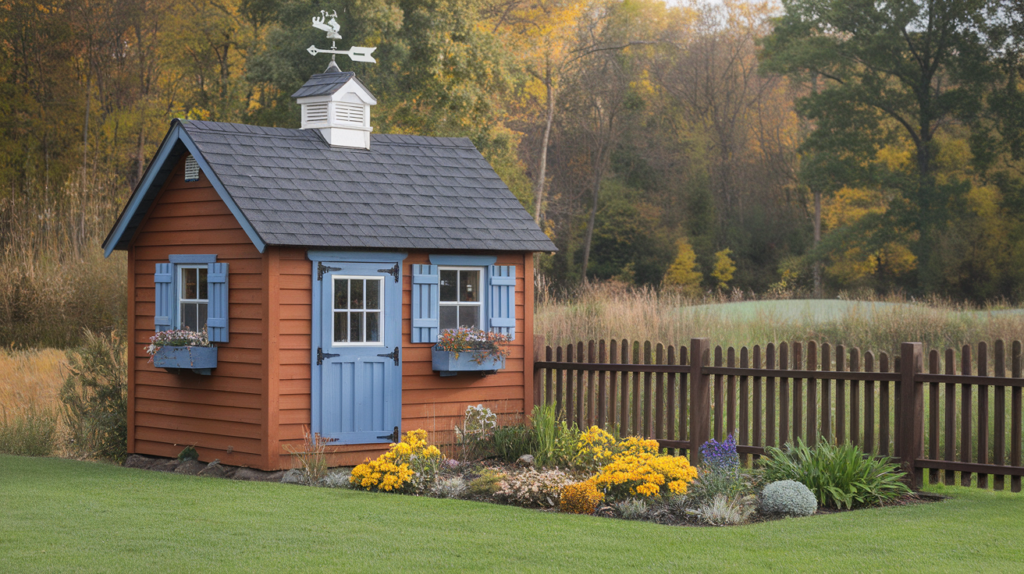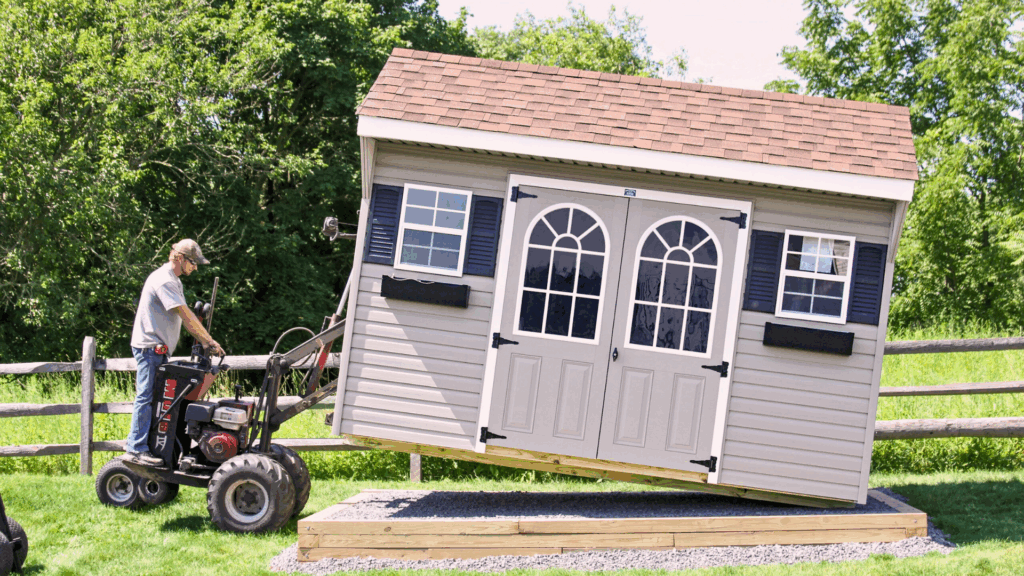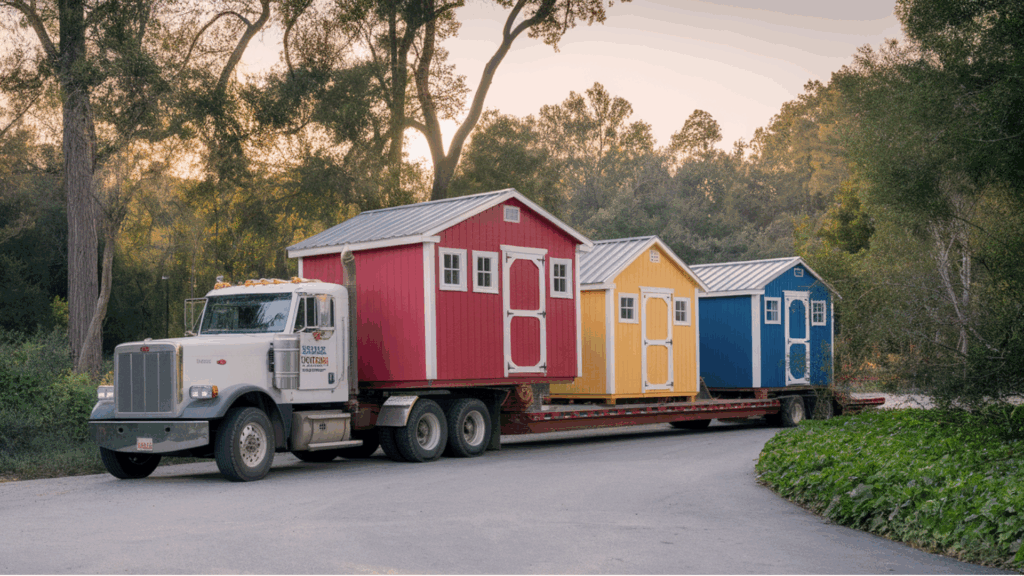Are you staring at a shed that needs to be moved, but are worried about the cost?
Whether you’re redesigning your backyard, preparing for a home sale, or simply wanting to reclaim some outdoor space, moving a shed isn’t as straightforward as you might think.
Most homeowners don’t realize how many factors impact shed moving expenses. Is it a small metal structure or a large wooden building? Will it travel across your property or state lines?
These details dramatically change the price tag. My guide cuts through the confusion.
I’ll break down:
- Typical moving costs
- Size and material factors
- Smart budgeting tips
By the end, you’ll understand exactly what to expect financially with just clear information to help you make a smart decision about your shed’s big move.
Average Cost to Move a Shed
Let me break down the real numbers for you. Moving a shed isn’t a one-size-fits-all situation.
Depending on your specific circumstances, you’re looking at a price range of $225 to $2,500, and sometimes even more for complex moves.
A local move across your yard might cost as little as $225. But if you’re thinking about relocating that shed across town? Prepare your wallet.
And this is what impacts your bottom line:
- Shed size: Smaller = cheaper
- Distance traveled
- Shed construction material
- Site accessibility
For most homeowners, hiring a professional starts around $500 to $1,000 for small to medium sheds. Want a ballpark? A short-distance move of a compact 8’x10′ shed typically runs about $750.
Pro tip: Metal sheds? Generally cheaper to move. Wooden sheds? They’re heavier and more complex, which means higher costs.
Remember that every shed move is unique. Your specific situation will determine the final price tag.
Factors that Affect the Cost of Moving a Shed

Moving a shed isn’t as simple as picking it up and dropping it somewhere else. Let’s see some nitty-gritty details that can make your wallet sweat.
1. Distance
The distance matters – big time. Moving a shed 10 feet across your yard? Cheap and quick. Transporting it 10 miles? That’s a whole different ballgame.
Expect costs to climb dramatically with each mile traveled. Long-distance moves can multiply your expenses by 10 or more.
2. Access
Imagine trying to move a massive shed through a narrow gate or around tight tree lines. Not fun, right? Tricky access points mean more labor, specialized equipment, and higher costs.
Professionals might need to remove fences, trim trees, or create temporary pathways. Each obstacle adds dollar signs to your moving bill.
3. Foundation Type
Some sheds sit on simple wooden skids; these are movers’ best friends. Others are anchored in concrete slabs or have complex base structures.
Concrete foundations? Prepare for extra work and higher expenses. Skid-mounted sheds can often be lifted and moved more easily, keeping your costs lower.
4. Shed Condition
Older sheds are like vintage cars – beautiful but fragile. If your shed has seen better days, it might need reinforcement before moving.
Rotting wood, weak joints, or structural damage can turn a simple move into a restoration project. Pro tip: A pre-move inspection can save you from unexpected repair costs.
5. Permits and Regulations
Believe it or not, moving a shed isn’t always a free-for-all. Local regulations can be very sneaky. Permit costs range from $15 to $500, depending on your location and shed size.
Depending on your area, you might need permits for oversized loads, road transport, or property placement.
6. Disassembly
Some sheds come apart more easily than others. Large wooden structures might need partial disassembly to move safely.
Metal sheds can often be transported in one piece. Each approach has its price tag. Disassembly adds labor hours but can prevent damage during transport.
Real talk: These factors aren’t just numbers – they’re the difference between a smooth move and a wallet-draining nightmare. Knowledge is your best friend when planning a shed relocation.
Cost Range by Size: Small, Medium, and Large Sheds
The cost of moving a shed varies based on its size and the complexity of the move.
- Small Sheds: Budget-friendly and lightweight, often moved by a small team with minimal equipment. Great for playhouses or small storage units.
- Medium Sheds: Slightly heavier, requiring specialized equipment and more time for maneuvering. Common for garden tool sheds.
- Large Sheds: Requires cranes, specialized trucks, and a bigger team to handle full-sized workshops or large storage buildings.
The size and weight of your shed directly affect the cost, so it’s important to plan accordingly to fit your budget.
| Shed Size | Move Cost | Typical Example | Labor Complexity |
|---|---|---|---|
| Small (up to 8×10 ft) | $200 – $700 | Backyard playhouse | Low |
| Medium (10×12 to 10×16 ft) | $500 – $1,200 | Garden tool storage | Moderate |
| Large (12×20 ft and up) | $1,000 – $2,500+ | Workshop or storage building | High |
Quick reality check: That cute little playhouse? Moves like a dream. Your massive workshop? Prepare for a more complex (and expensive) relocation.
DIY vs Professional
Moving a shed yourself might seem doable, but it’s not a simple task. While it’s technically possible, it’s not a weekend project for the faint-hearted.
Trust me, I’ve seen enough DIY disasters to know it’s best to call in professionals for a safe and smooth move.
| DIY Moving | Professional Moving |
|---|---|
| Pros | Pros |
| Potentially save money | Guaranteed professional handling |
| Learn new skills | Proper equipment guaranteed |
| Complete control | Insurance coverage |
| Cons | Cons |
| High risk of damage | More expensive |
| Potential personal injury | Less personal control |
| Need to rent/buy equipment | Scheduling dependent |
| Lack of professional expertise | Additional fees possible |
Pro tip: If your shed is small, relatively light, and you’re just moving it across your yard, DIY might work. Anything more complicated? Save yourself the headache and call the pros.
How to Save Money when Moving a Shed?

Moving a shed doesn’t have to cost a fortune. With some smart planning, you can keep more cash in your pocket while getting the job done right.
1. Timing is Everything
Believe it or not, when you move matters. Late fall and winter are typically slower seasons for moving companies.
Contractors often have fewer jobs, which means they might offer lower rates. Schedule your shed move during these quieter months, and you could save 10-20% on labor costs.
2. Do Some Prep Work
Every hour a professional works costs you money. Want to cut costs? Do some groundwork yourself. Empty the shed completely. Clear the path.
Remove any obstacles between the current and the new location. The less time professionals spend preparing, the less you’ll pay.
3. Get Multiple Quotes
Don’t settle for the first price you hear. I recommend getting at least three quotes from different moving companies. Some might offer package deals or seasonal discounts.
Pro tip: Be upfront about shopping around – some companies will lower their price to win your business.
4. Consider Partial DIY
You don’t have to do everything yourself, but you can split the work.
Perhaps you handle the shed emptying and site preparation, while professionals do the actual moving. This hybrid approach can significantly reduce your overall costs.
5. Minimize Distance
Shorter moves cost less. If possible, plan a route that’s as direct and short as possible.
Avoid complicated terrain or routes that require special permits. Every mile adds to your final bill.
6. Repair Before Moving
Addressing minor repairs before the move can prevent costly damage during transport.
A few dollars spent on wood sealant or fixing loose boards could save you hundreds in potential repair costs later.
Conclusion
Take a deep breath. Moving a shed doesn’t have to drain your bank account or stress you out completely. With the right planning, you can tackle this project without breaking the bank.
Remember, your biggest cost factors are:
- Shed size
- Moving distance
- Site accessibility
- Professional vs. DIY approach
Time is money, and shed moving proves that point perfectly. Weigh your skills, equipment, and comfort level carefully.
Most local moving specialists offer free quotes – a quick call can save you hundreds of dollars and countless headaches.
They’ll assess your specific situation and give realistic advice. When in doubt, ask a local pro for a quick quote. It’s free, fast, and could be the smartest move you make.

